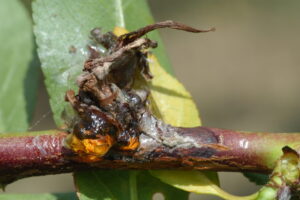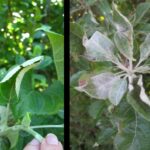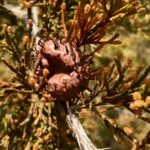All that new, succulent growth needs to be protected to prevent primary (and even secondary!) scab (Fig. 1). We’re past the point where copper can be safely used, so protectant fungicides for scab control at this stage include mancozeb, ziram and captan. As an added bonus, all of these protect against the summer rots, and mancozeb provides some protection against rust. Early applications of FRAC M fungicides (captan, ziram, mancozeb) improved bitter rot management, in particular. Keep in mind that with warmer weather, scab infection can occur in as little as 6 hours (See Table 1. Mill’s table below). Making sure trees are thoroughly protected before the infection periods is essential, as there are no guarantees of orchard entry after heavier rainfalls (or, more correctly, getting out of the orchard).

Figure 1. Apple scab infects all green portions of the plant. Be sure to look at both sides of the leaf! If your FRAC M fungicides aren’t coating the leaf undersides, half the tree is unprotected! Photo by Janna Beckerman.
In addition to protecting against scab, keep your eyes out for powdery mildew, which tends to be worse after a mild winter. For powdery mildew and/or rust issues (Fig. 2, 3), include any FRAC 3 (Cevya, Rally, Indar, Procure or Topguard) OR FRAC 7-11s (Luna Sensation, Merivon, Pristine). Bot the 7-11 fungicides and FRAC 3 fungicides prevent scab, rust and powdery mildew. Or, just use the FRAC 7s (Aprovia, Fontelis, or Sercadis) and save your FRAC 11 fungicides (QoI, or quinone outside inhibitors, like Flint, Flint Extra or Sovran) for later in the season for bitter rot. Remember, captan does not control powdery mildew or rust!
- Figure 2. Powdery mildew of apple. Symptoms include leaf curl (left) whereas the white coating is a diagnostic sign of disease. Photos by Janna Beckerman.
- Figure 3. Juniper rust is coming in hot off the junipers, to infect susceptible apple and pear trees. The orange spore horns are dessicated in dry weather but will rehydrate and release spores. Photo by Janna Beckerman. Link to video shows the rehydration process! Photo by Janna Beckerman.
For those to the north, and at tight cluster through pink: Assuming trees have less than 3” of new growth, you can still apply Apogee. Early applications of Apogee will help prevent fire blight in what is shaping up to be a warmer, wet spring. With temperatures flirting with 70, fire blight needs to be on your radar–apply Apogee if you still can!
For those at bloom: Balancing spraying demands between the potential for fire blight and the constant reality of apple scab, powdery mildew, summer rots and rust, (and insects!) is a challenge, which is why we refer to this period as ‘crazy tank mix time’. During this time, let’s not forget about protecting pollinators: We need them, and they need us to be mindful of what and when we are spraying! We also need to remember that blooms are delicate—and captan is pretty ‘hot’. Avoid captan at this time, and use mancozeb or ziram for scab, rust and rot control for your tank mix partner or protectant chemical of choice. Again, on-going studies suggest that the summer rot pathogens, but especially bitter rot, infect susceptible varieties earlier than previously believed, especially when weather is warm and wet, and that secondary infection period continues throughout the growing season.
For fire blight control on those susceptible varieties, like Jonathan, Fuji, Gala, Ginger Gold, etc., be sure to use streptomycin as we have not identified any streptomycin resistance in Indiana to date. Streptomycin is most effective when applied with Regulaid during slow drying conditions (like at night) at king bloom, and then repeated every 3-5 days after until petal fall. As an added bonus, you’ll protect your pollinators. Repeated application of streptomycin+Regulaid until petal fall ensures efficacy (streptomycin breaks down after a few days) and reduces the risk of resistance. Keep in mind that Regulaid, as a penetrant, does increase your risk of phytotoxicity (Fig. 1). Forewarned is forearmed.
Table 1. Number of days required for lesions to appear after infection has been initiated. No further wetting is required. Additional days may be required if conditions are unfavorable for lesion development (prolonged periods above 80° For very dry weather). Data of MacHardy & Gadoury (1989); and Stensvand, Gadoury, & Seem (1997).
| Table 1. Revised Mills Table. Approx. hours of wetting necessary to produce primary apple scab infections, and approx. number of days required for lesions to appear, at different average temperatures. From the NEWA website at: http://newa.cornell.edu/index.php?page=revised-mills-table | ||
| Temperature (˚F) | Hours [1] | Lesions Appearance (days) [2] |
| 34 | 41 | – |
| 36 | 35 | – |
| 37 | 30 | – |
| 39 | 28 | – |
| 41 | 21 | – |
| 43 | 18 | 17 |
| 45 | 15 | 17 |
| 46 | 13 | 17 |
| 48 | 12 | 17 |
| 50 | 11 | 16 |
| 52 | 9 | 15 |
| 54-56 | 8 | 14 |
| 57-59 | 7 | 12-13 |
| 61-75 | 6 | 9-10 |
| 77 | 8 | – |
| 79 | 11 | – |
For those at petal fall: A FRAC 3 + mancozeb will provide varying degrees of protection against all the major diseases assuming coverage is adequate. Just like during bloom, inclusion of mancozeb provides additional protection against the summer rots, especially bitter rot. With its 77 day PHI, this may be your last, or close to your last application.
Stone Fruit
Blossom rot (Fig. 4) never sleeps, and is particularly active under wet, moderate temperatures, like we have now. For those of you lucky enough to still have peaches and other stone fruit, be sure to protect your crop with iprodione (Rovral, Meteor) at bloom. Do not apply iprodione after petal fall.

Figure 4. Brown can be a problem even when there isn’t a crop. Here, it is infecting a young shoot. Photo by N. Lalancette.
If bacterial spot has been a problem, apply fire line or mycoshield at 7-day intervals from petal fall/shuck split to first cover. Avoid copper if the conditions are wet, and see the Midwest Fruit Pest Management Guide for more information, because it is complicated, and you don’t want to make any mistakes.
To control blossom rot and peach scab at shuck split, I like a final application of Bravo Weatherstik (FRAC M), but other options include FRAC 11 (Abound; FRAC 7-11 Luna Sensation, Merivon or Pristine); FRAC 1(Topsin M) with or without captan; and FRAC 3(Indar, Inspire Super, Rhyme/Topguard Specialty Crop) or the premix Topguard EQ (FRAC 3+11). FRAC 3 fungicides improve powdery mildew management, if you are struggling with PM control in your stone fruit.

